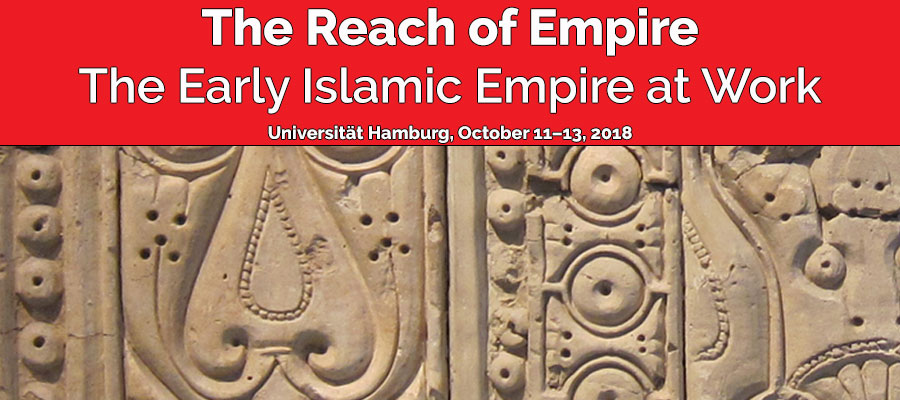The Reach of Empire - The Early Islamic Empire at Work, Universität Hamburg, October 11–13, 2018
As the ERC project “The Early Islamic Empire at Work – The View from the Regions Toward the Center” nears its end, its final conference invites participants to consider the reach of the early Islamic Empire from the 7th to the 10th centuries CE.
When we talk about the reach of the early Islamic empire, we usually consider the geographical extent it encompassed, from the Hindukush to the Atlantic. However, the question of reach is a more intricate one that also entails the depth of military and administrative control over and within these vast regions. For instance, the geographical reach is closely related to the ways in which central and provincial authorities engaged communities on the territorial margins within each region. Imperial authorities did not exert the same level and type of influence over every community and place in the empire; forms of rule varied from the imperial cities to the frontier settlements, from the agricultural basins to the mountain areas, and from urban settlements to the steppes.
What strategies did the empire employ to integrate peoples and elites of different provinces, ethnicities, and confessions within its administrative and bureaucratic structures? Which areas fell outside the central control of the empire, when did they do so, and why? How did the reach and type of control strategies employed by imperial authorities (d)evolve over time? Conversely, the process of negotiation between imperial and regional authorities also manifested itself in how communities responded to, or even shaped, these imperial strategies. To what extent, for example, did communities in the provinces seek integration in exchange for the potential benefits of empire? Alternatively, what motivated them to resist deeper integration? Should the wider process of regionalization that began in the 9th century CE be understood as successful provincial resistance, imperial failure, or simply an alternative form of negotiating empire?
The conference will also discuss the economic and fiscal reach of the early Islamic empire, which concerns its interest in fiscal extraction. The empire was very successful in maintaining a tax-driven administration. The monetization of the fiscal system allowed the transfer of wealth across the empire, and the extensive road and caravan networks further facilitated trade and monetary structures that connected regions which were geographically and culturally distant. The circulation not just of money, but also of industrial goods and merchandise created an imperial style from North Africa to Central Asia. On the other hand, regional currencies and industrial traditions remained highly visible until the 9th century CE, and re-appeared forcefully after the 940s. We would therefore like participants to discuss the ways in which economic structures and networks served as tools of imperial integration on the one hand, and as resources of both local resistance and belonging on the other.
The reach of empire also manifested itself in a range of integrating factors related to the provision of justice and the spread of Islam as an ‘imperial’ religion. How did the early Islamic Empire cultivate a legal system (or rather, systems) in light of the fact that the majority of the empire’s subjects remained non-Muslim during the 7th-10th centuries CE? How did the empire’s practice of dispersing justice operate alongside well-established Sasanian, Roman, Christian, Jewish, Zoroastrian and even Buddhist legal traditions? Throughout the early period, most of these legal systems flourished and formulated main corpora of their own doctrine, resulting in a rich tapestry and manifold forms of regional and local rulings.
We invite papers that consider the reach of law, Islamic and other, for the integration and functioning of the empire, as well as its role in the development of Islam as an ‘imperial’ religion. To what extent did ‘Islam’ serve as an integrating force, even if only for the imperial elite? How did the dimension of religion, conversion, and non-Muslim status relate to the reach of the empire, its various levels of integration, and the means by which integration was attained or resisted? The development of Islamic law in the late 8th and 9th century CE provided a crucial resource for regulating the empire’s workings. To what extent were the legal and religious dimensions of empire effective in extending its reach?
Apart from more conceptual papers, we encourage contributors to provide case studies that specifically respond to the conference’s themes and questions by elucidating the economic, socio-political, and legal dimensions of empire. The elements listed above are not exclusive, and further approaches to understanding the reach of the early Islamic Empire are welcome.
